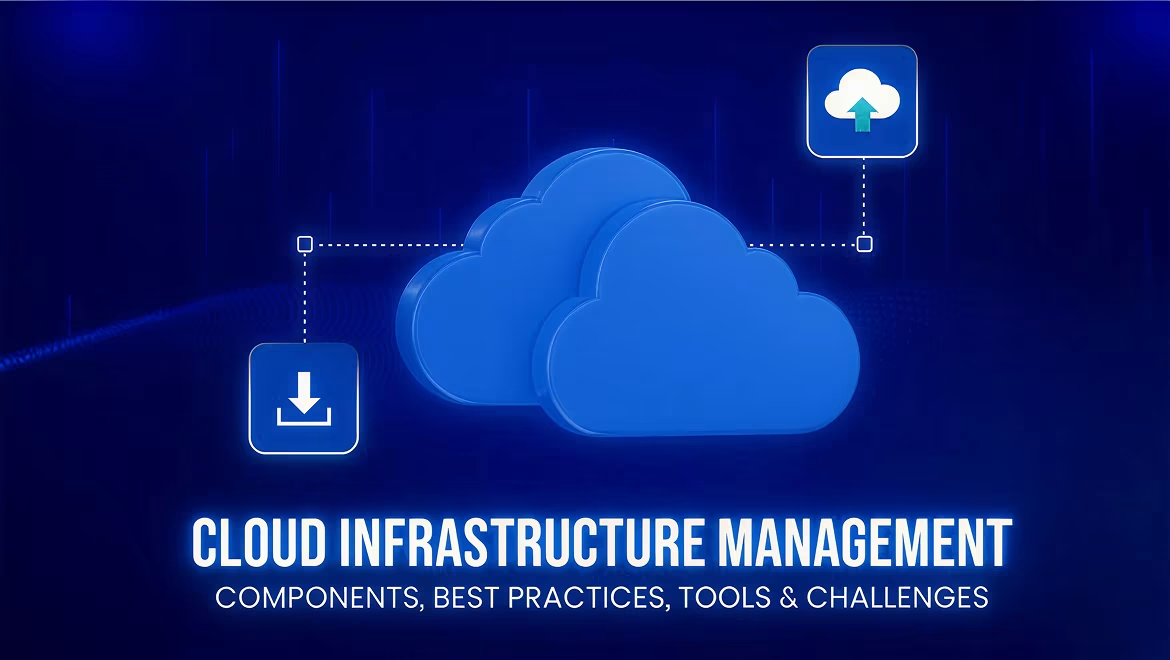

- By ACI
- 07 October, 2025
- 6 min Read
Cloud Infrastructure Management: Components, Best Practices, Tools & Challenges
In today’s digital era, businesses rely heavily on cloud computing to host their data, applications, and critical services. Cloud Infrastructure Management (CIM) plays a vital role in ensuring that these cloud environments run smoothly, securely, and efficiently. It involves overseeing and optimizing servers, storage, networks, and virtual resources that make up your cloud ecosystem. Proper management helps businesses scale faster, enhance security, reduce downtime, and control costs — all while maintaining high performance. In this blog, we’ll explore what cloud infrastructure management is, its key components, best practices, challenges, and the top tools that can help you streamline operations.
What Is Cloud Infrastructure Management & Why It’s Important?
What Is Cloud Infrastructure Management?
Cloud Infrastructure Management refers to the systematic process of monitoring, controlling, and optimizing cloud-based resources such as servers, networks, databases, and storage systems. Platforms like Amazon Web Services (AWS), Microsoft Azure, and Google Cloud Platform (GCP) provide these infrastructure components that businesses can manage and scale as needed. Unlike traditional on-premise infrastructure, CIM provides on-demand scalability, automation, and global availability — allowing organizations to meet fluctuating workloads with ease.
Why Is Cloud Infrastructure Management Important for Modern Businesses?
Modern enterprises depend on the cloud for critical workloads, which makes effective management essential for:
- Scalability: Dynamically adjust resources based on usage demand.
- Automation: Reduce manual tasks with automated provisioning and monitoring.
- Uptime & Reliability: Minimize downtime and ensure business continuity.
- Data Security: Maintain compliance and protect sensitive data from breaches.
Benefits of Cloud Infrastructure Management:
- Enhanced performance and flexibility
- Cost control through efficient resource allocation
- Centralized visibility across multi-cloud environments
- Faster deployment cycles
Core Components of Cloud Infrastructure
Cloud infrastructure consists of multiple integrated components that power cloud operations:
1. Compute:
Virtual machines (VMs), containers, and serverless functions form the computational backbone. Platforms like AWS EC2, Google Compute Engine, and Docker provide scalable compute resources
2. Storage:
Cloud storage comes in three main types:
- Object Storage: Ideal for large unstructured data (e.g., Amazon S3).
- Cannot easily share patient data outside the organization.
- Less effective for population health management.
3. Networking:
Virtual networks, firewalls, and load balancers ensure secure, fast communication between services and users.
4. Cloud Services & Tools:
Monitoring, automation, and security layers — such as CloudWatch, Azure Monitor, and Kubernetes — streamline management and performance optimization.
Key Aspects of Cloud Infrastructure Management
Effective cloud infrastructure management revolves around several critical aspects:
- Resource Provisioning: Allocating compute, storage, and network resources as per demand.
- Automation & Orchestration: Automating workflows using IaC tools like Terraform and Ansible.
- Security & Compliance: Implementing firewalls, encryption, and compliance standards such as ISO, SOC 2, and GDPR.
- Monitoring & Performance Tracking: Using real-time analytics to detect and fix issues proactively.
- Cost Optimization & Budgeting: Tracking usage to prevent over-provisioning and reduce cloud spend.
Best Practices for Effective Cloud Infrastructure Management
To ensure seamless cloud performance and control, follow these proven best practices:
- Implement Infrastructure as Code (IaC): Tools like Terraform and AWS CloudFormation enable scalable, repeatable setups.
- Use Automated Monitoring & Alerts: Set up continuous performance checks with Datadog, New Relic, or Prometheus.
- Adopt Multi-Cloud or Hybrid Strategies: Avoid vendor lock-in and improve redundancy.
- Ensure Continuous Security Compliance: Regular audits and vulnerability assessments protect data integrity.
- Conduct Regular Cost Audits: Evaluate your resource usage monthly to eliminate waste and optimize billing.
Common Challenges in Cloud Infrastructure Management
While cloud computing offers immense benefits, it also brings unique challenges:
| Challenge | Description | Solution |
|---|---|---|
| Cost Overruns | Uncontrolled scaling can lead to budget overflow. | Use budgeting tools and set spending alerts. |
| Data Security Vulnerabilities | Misconfigurations may expose data. | Apply encryption and role-based access control. |
| Lack of Visibility | Managing multi-cloud setups can obscure resource usage. | Implement centralized dashboards for visibility. |
| Compliance Complexity | Global standards like GDPR require strict controls. | Use compliance automation frameworks. |
| Downtime or Latency Issues | Poorly optimized workloads can cause | Deploy load balancers and use distributed zones. |
Addressing these challenges early ensures smooth cloud operations and stronger resilience.
Technologies & Tools Used in Cloud Infrastructure Management
Cloud management tools play a vital role in automation, monitoring, and optimization.
Infrastructure as Code (IaC):
- Terraform
- AWS CloudFormation
- Pulumi
Monitoring & Observability:
- Datadog
- New Relic
- Prometheus
- AWS CloudWatch
Automation & Orchestration:
- Kubernetes
- Docker
- Ansible
Cost Optimization & Governance:
- CloudHealth by VMware
- Spot.io
- Azure Cost Management
These tools collectively simplify infrastructure deployment, enhance performance, and reduce operational overhead.
Conclusion
Effective Cloud Infrastructure Management ensures that your cloud ecosystem remains secure, cost-effective, and high-performing. By leveraging automation, adopting best practices, and using the right tools, organizations can maintain scalability and compliance effortlessly.
If you’re looking to optimize your business’s cloud infrastructure, consider partnering with a professional cloud management team to unlock higher efficiency and growth.



